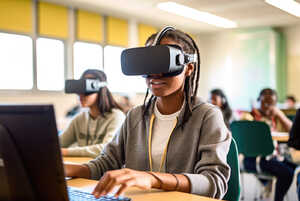Thought Leadership
How Does Technology Prepare Students for a Future in STEM Fields?
In the last decade, there has been a rapid growth in the number of students opting to take on STEM subjects into higher education, with the acceptances into post-graduate computer science courses alone having risen by almost 50% between the years 2011 and 2021 and engineering course enrolment increasing to 21% in the same time frame.
Those core STEM subjects: science, technology, engineering and mathematics, provide students with the education and practical expertise required for numerous vital industry sectors: from healthcare and IT to architecture and aviation.
While the range of career paths that are open to both men and women as a result of STEM-based education is wide and varied, it’s crucial that schools are equipped with the necessary facilities and learning opportunities for students to thrive within these subjects.
But, for those students looking for a career in the STEM fields, how can digital technology help in the process?

A new age of technology
enhanced learning
It’s hard to understate the impact ICT has had on the education system over the last two decades. At the turn of the millennium, computers in schools were found only in computer labs and restricted for use in IT-based subjects. Now they can be found in every classroom; an essential tool for every learning environment imaginable, including those all-important STEM fields.
Flexibility and collaboration through online learning
In the post-COVID educational landscape, online learning has remained a crucial pedagogical tool within STEM fields; one which, when complemented with traditional teaching practices, encourages innovation and hands-on experience for students. Through easy-to-use collaborative online platforms such as Google Workspace for Education Fundamentals, students and teachers have a simple and secure way to share documents and work simultaneously on projects from any device and from any location.
Platforms like Microsoft Teams provide dedicated spaces for discussion, group projects, and peer-to-peer interactions. Students can engage in virtual study sessions, collaborative problem-solving, and knowledge sharing—all from the device of their choice.
Meanwhile, adaptive learning technologies have gained prominence in STEM education in recent years; tailored education experiences that attune to individual students' needs and proficiency levels. Personalised content that challenges them according to their capabilities ensures that each student receives targeted support, helping them progress and master challenging STEM concepts more effectively.

Project-based
interdisciplinary learning
This cutting-edge pedagogical model uses digital technology tools to enhance learning experiences for students within the STEM disciplines—with the end goal of engaging students in practical, hands-on projects or challenges in science, technology, engineering and mathematics subjects. By making that vital connection between these disciplines, project-based interdisciplinary learning aims to provide students with a more comprehensive understanding of real-world problems and scenarios.
Simulation and virtual reality models
There are a variety of simulation models that support STEM education; with students given the opportunity to engage in both virtual and actual environments to develop the key skills that are crucial for their chosen STEM subject. A simulation mode is typically built on a baseline of a practical, real-world experience; whether that’s a simulated animal dissection or the inner workings of a computer circuit board. In a tough economic climate, a school’s budget is always under scrutiny–and, within the STEM fields, equipment can be expensive and difficult to source. Simulated environments provide students with the experiences and vital learning tools that might otherwise be unavailable to them in a traditional STEM classroom.
Meanwhile, AR and VR tools can create immersive learning environments for students within their STEM education. In science subjects, students can benefit from the use of visual, interactive experiences through generated 3D models, helping children understand new and often complex ideas with more efficiency–a method that has been proven to improve grades in STEM subjects.
Virtual reality labs can provide students with otherwise inaccessible education scenarios. Instead of learning about the molecular structure of a chemical compound in a textbook, through VR labs, students can view it for themselves with a virtual zoom. With the help of technology, they can make that all-important connection between science theory and practical application, with the ability to course-correct experiments without costly mistakes. AR and VR can be used to help train medical students, create immersive geometry lessons, and construct simulations for engineering exercises; all from the comfort of a safe and controlled classroom environment.

The use of embedded
assessments
In its purest form, education is a way to channel a child’s intrinsic necessity to develop skills. From an early age, a child’s brain is constantly generating connections that help build the world around them; neurological bonds that encourage problem-solving, collaboration, and communication. Throughout school and into adulthood, these key skills can be developed and enhanced through the use of technology.
Embedded assessments are a proven method of enhancing a child’s learning potential, providing students with ongoing, tailored, and subject-specific self-assessment. When implemented correctly, these assessments can be integrated seamlessly into instructional material, allowing students to reflect on the quality of their explanations, models, or problem-solving within their STEM lessons and coursework.
Online platforms such as Microsoft Teams Assignments and Google Classrooms facilitate the creation and execution of these assessments. Students can engage with multimedia content, interactive simulations, and virtual experiments, allowing for a more dynamic assessment experience. The real-time feedback generated by these assessments helps students make immediate adjustments, transforming the learning process into a continual pattern of self-improvement. From audio and video feedback, text-to-speech, to immersive reader; these key evaluation tools are designed to support learners of all capabilities.
What’s more, embedded assessments provide educators with valuable insights into each student's learning journey within their chosen STEM field. Teachers can gain a more comprehensive understanding of individual students' thought processes, misconceptions, and, chief of all, their progress. This data-driven approach allows teachers to adjust and refine their teaching strategies to address specific student needs.
How can Computeam help?
Through the rising ubiquity of technology in society over the last two decades, the modern student is now digitally fluent–and, as such, requires a different learning environment to that of past generations.
In the information age, technology use is no longer just an option for schools, but an integral building material for the education experience as a whole, particularly in STEM fields. With the right ICT training and funding, education leaders now have the chance to create online learning opportunities for students looking for a career in STEM industries and to ensure these learning environments are more accessible alongside traditional classroom models. If you’d like to find out more about how technology can benefit your school’s STEM education programme, then please get in touch.
What is the Future of Virtual
Reality in Education?
While virtual reality might seem very much like a 21st-century invention, its introduction into popular culture—at least as a concept—can be traced all the way back to the 1930s.
Posted on September 6th 2023




 Learning Locker
Learning Locker Climate project
Climate project